SpaceX’s 4-ton rocket is about to collide with the Moon at a speed of more than 9,000 km/h
- Tram Ho
By now, the vast majority of us are probably familiar with SpaceX’s Falcon 9 recycled rocket launch process. When the capsule of the rocket flies into space, the propulsion assembly will automatically land on the platform. Or at least, that’s the usual procedure.
During a mission carried out in 2015, SpaceX received a project from the National Oceanic and Atmospheric Administration, launching to the Deep Space Climate Observatory. The launch took place almost completely, when the rocket cluster failed to return to Earth.

The launch event took place in 2015.
The report said a lack of fuel was the reason why the lower part of the rocket could not return, and caused the entire propulsion cluster to float in space. After a journey lasting more than half a decade, the propulsion cluster is expected to collide with the lunar surface in early March; 4 tons of “scrap” will fall at a speed of 2.5 km / s, equivalent to 9288 km / h.
After examining all the relevant data, Bill Gray, an astronomical enthusiast and successful developer of software to track the position of objects flying near Earth, concluded that Falcon 9’s engine assembly will fall to the Moon on March 4, it will most likely fall to the far side of “Hang’s house”.
However, Bill Gray did not dare to confirm the accuracy of the collision. On his website, he writes: “ If this were a rock, I would be 100% sure… But space junk would be a bit more complicated .”

He continued: “ I have a fairly complete mathematical model of the behavior of the Earth, Moon, Sun and planets, and how their gravity acts on the object. I have an assumption about how sunlight pushes the object away, gently sending it away from the Sun. These data often allow me to make predictions with confidence .”
Mr. Gray said he will try to calculate as accurately as possible, so that two US and Indian lunar exploration satellites can capture the collision point for further research. The event taking place in early March will mark the first time that a man-made object has fallen to the surface of the Moon without purpose.
Currently, SpaceX is planning to send people to the Moon to establish an outpost for humanity. However, this collision will send the SpaceX spare to the Moon sooner than expected.
Source : Genk
